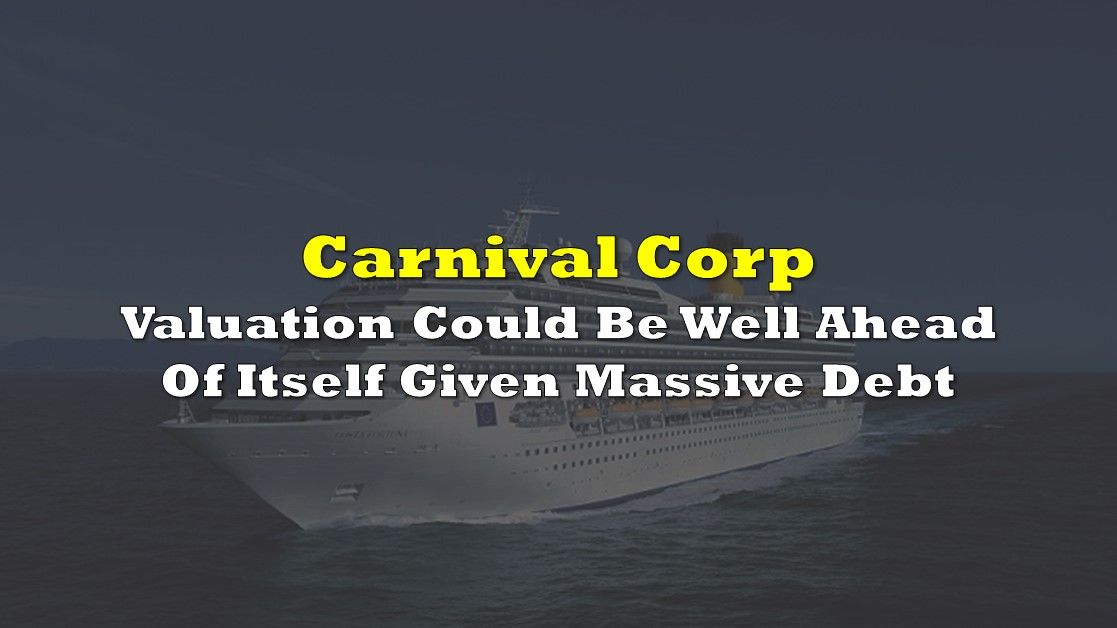On June 24, Carnival Corporation (NYSE: CCL), the world’s largest cruise line operator, reported an adjusted loss of about US$2 billion for 2Q FY2021 (quarter ended May 31, 2021). Investors reacted little to the large loss, a reaction which has become customary for popular economy re-opening plays, as investors instead focus on the company’s almost certain snap-back in the second half of 2021 from the depressed levels of 2H 2020.
The effects of a dramatic increase in debt and dilution are, for now, being brushed aside.
To decide whether Carnival investors should be little concerned about the company’s valuation and recent losses, it is instructive to examine the enterprise value (EV) of post-pandemic Carnival to its pre-pandemic financial situation. Carnival, like many companies tied to discretionary spending, had to issue significant amounts of debt and equity to remain afloat as consumer entertainment outlays fell to negligible levels last year.
As of November 30, 2019, the end of Carnival’s last fiscal year before COVID-19, Carnival’s EV was about US$43.3 million, and the company’s revenue and operating cash flow totaled US$20.8 billion and US$5.5 billion, respectively, in fiscal 2019. Consequently, as of late November 2019, Carnival stock was trading at the following valuation ratios: EV/Revenue and EV/Operating Flow of approximately 2.1 and 7.9, respectively.
As of May 31, 2021, Carnival’s share outstanding were around 1.2 billion, about 70% more than 18 months ago. Even more troubling, its debt has nearly tripled to US$32 billion from 18 months prior. Factoring this in, as well as the Cardinal’s current share price of US$26.34, the company’s EV is now approximately $54.3 billion.
Cardinal is therefore now trading at about 20% higher EV/Revenue and EV/Operating Cash Flow ratios, based on FY2019 pre-pandemic sales and cash flows, than it did 18 months ago when the demand for cruises was robust and there was no fear about potentially contracting a deadly virus aboard one of their vessels. Moreover, it is uncertain if — and certainly when — Carnival’s revenue and cash will ever reach its FY 2019 levels.
| 30-Nov-19 | 31-May-21 | |
| Carnival Share Price | $47.00 | $26.35 |
| Shares Outstanding (US$ Millions) | 688 | 1,190 |
| Stock Market Value (US$ Billions) | $32.3 | $31.4 |
| Debt (US$ Billions) | $11.5 | $32.2 |
| Cash (US$ Billions) | $0.5 | $9.3 |
| Enterprise Value (US$ Billions) | $43.3 | $54.3 |
| FY 2019 Full Year Revenue (US$ Billions) | $20.8 | |
| FY 2019 Operating Cash Flow (US$ Billions) | $5.5 | |
| EV/Revenue | 2.1 | 2.6 |
| EV/Cash Flow | 7.9 | 9.9 |
Both Debt and Shares Outstanding Have Increased Rapidly Over the Last Twelve Months
As Carnival’s revenues nearly vanished due to the pandemic — and due to many governments’ strict treatment of cruise ships for health and safety reasons — the company’s debt increased about US$10 billion between May 31, 2020 and May 31, 2021. Similarly, Carnival’s average shares outstanding has soared from around 721 million in the quarter ended May 31, 2020 to 1.132 billion in the May 2021 quarter. Carnival’s operating cash flow shortfall has averaged about US$1.5 billion per quarter over the last three reported quarters.
| (in millions of U.S. $, except for shares outstanding) | 2Q FY21 | 1Q FY21 | 4Q FY20 | 3Q FY20 | 2Q FY20 |
| Revenue | $50 | $26 | $34 | $31 | $740 |
| Operating Income | ($1,616) | ($1,523) | ($1,642) | ($2,333) | ($4,177) |
| Oper. Cash Flow | ($1,359) | ($1,503) | ($1,652) | ($2,845) | ($2,720) |
| Cash/Investments – Period End | $9,271 | $11,514 | $9,513 | $8,176 | $6,881 |
| Debt – Period End | $32,234 | $32,729 | 28,380 | $26,342 | $22,250 |
| Average Shares Out. (Millions) | 1,132 | 1,095 | 920 | 775 | 721 |
It is possible that, in time, the number of Carnival’s cruise passengers will be significantly higher than during fiscal 2019. This could occur if financial markets remain buoyant, as the wealth effect is one of the key drivers in the cruise line business. Likely increases in worldwide vaccination rates should also be a positive contributing factor.
Investors seem to have ignored the negative factors of increased debt and stock dilution in their assessment of Carnival’s valuation. The business is likely to snap back in 2H 2021, but this looks more than fully discounted in Carnival’s share price. It is unclear if (and/or when) the company’s revenues and cash flows will ever reach pre-pandemic levels.
Carnival Corporation & plc last traded at US$26.06 on the NYSE.
Information for this briefing was found via Sedar and the companies mentioned. The author has no securities or affiliations related to this organization. Not a recommendation to buy or sell. Always do additional research and consult a professional before purchasing a security. The author holds no licenses.




